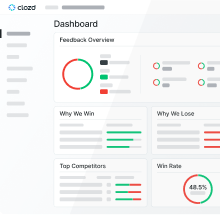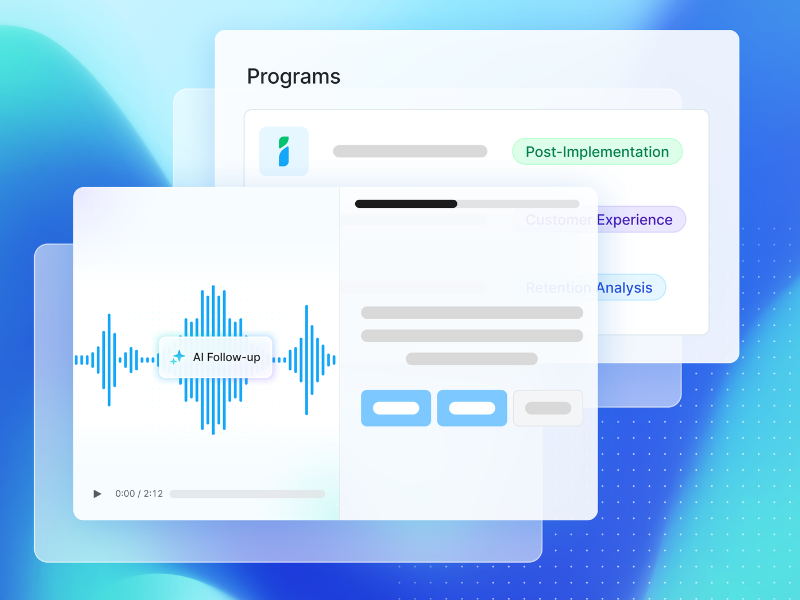As a sales leader, your core mission is clear: drive consistent, predictable revenue growth. You're constantly focused on hitting targets, accelerating pipeline velocity, boosting win rates, and maximizing deal size. But in today's competitive B2B landscape, simply pushing harder isn't enough. You need a strategic edge, a way to truly understand why you win and, more importantly, why you lose.
This is where win-loss analysis becomes indispensable. It's not just another data point; it's a powerful, often underutilized, strategy that provides the deep insights necessary to optimize your sales engine and unlock significant revenue growth. This guide will show you how sales leadership can leverage win-loss analysis to achieve these critical objectives.
What is Win-Loss Analysis and Why It Matters for Sales Leaders?
At its heart, win-loss analysis is the systematic examination of your won and lost deals. Its primary purpose in sales operations is to uncover the true reasons behind sales outcomes, directly from the buyer's perspective. This goes far beyond what your sales reps might log in the CRM. It's about understanding the buyer's journey, their decision-making process, and the factors that ultimately swayed their choice.
For sales leaders, this analysis is critical because it provides actionable insights that directly impact your most important metrics:
- Win Rate: By understanding why you lose, you can address weaknesses and improve your win rate. Conversely, knowing why you win helps you replicate success.
- Pipeline Velocity: Identifying common objections or process bottlenecks can streamline your sales cycle.
- Forecasting Accuracy: Deeper insights into market dynamics and competitive positioning lead to more reliable forecasts.
- Revenue Growth: Ultimately, every improvement in win rate, deal size, and sales efficiency translates directly to increased revenue.
While there's no single "good" win-loss ratio in sales, the goal isn't just to hit a number, but to continuously improve it. Win-loss analysis provides the roadmap for that improvement.
The Strategic Edge: How Win-Loss Analysis Fuels Revenue Growth
Win-loss analysis offers a unique lens into your sales performance, providing the strategic intelligence needed to drive sales and revenue. Here's how it empowers sales leaders:
1. Uncovering True Buyer Insights
Your sales team has a perspective, but the buyer's perspective is the one that truly matters. Win-loss analysis, especially through unbiased, third-party buyer interviews, provides direct feedback that often contradicts internal assumptions. This in-depth insight helps you understand:
- Why buyers chose you (or a competitor): Was it product features, pricing, sales experience, or company reputation?
- Their decision-making criteria: What were their priorities? What value propositions resonated most?
- Unspoken objections: What concerns did they have that your sales reps might not have fully captured?
This authentic feedback is a key to a successful revenue leader, allowing you to tailor your approach to what potential customers truly need and value.
2. Sharpening Sales Strategies and Process
With direct buyer feedback, you can pinpoint specific areas for improvement within your sales strategies and sales process. This helps you improve win rate by:
- Identifying process gaps: Are deals stalling at a certain stage? Is your qualification process effective?
- Optimizing messaging: Do your value propositions resonate? Are your sales reps effectively articulating your unique selling points?
- Refining sales plays: Which strategies consistently lead to wins? Which ones need adjustment?
By understanding where your sales process breaks down or excels, you can make data-driven decisions to enhance sales effectiveness and productivity.
3. Boosting Competitive Intelligence
Win-loss analysis is an unparalleled source of competitive intelligence. Buyers often reveal candid details about your competitors, including:
- Their strengths and weaknesses: What did buyers like or dislike about competitor offerings?
- Pricing strategies: How do your prices compare, and how is that perceived?
- Market positioning: How do buyers view your company versus others in the market?
This insight allows you to refine your competitive strategy, develop effective counter-messaging, and better position your offerings against rivals.
4. Enhancing Product and Pricing Strategies
Sales leaders are often the first to hear about product gaps or pricing objections from the market. Win-loss analysis formalizes this feedback loop, providing product and pricing teams with actionable data on:
- Product fit: Are your features meeting market needs? What's missing?
- Pricing perception: Is your pricing aligned with perceived value? Are there common objections?
This cross-functional alignment ensures that product development and pricing adjustments are informed by real-world buyer experiences, leading to offerings that are more competitive and desirable.
5. Empowering Sales Team Effectiveness Through Coaching
Win-loss insights provide a powerful foundation for targeted sales coaching and training initiatives. By analyzing patterns across deals, you can identify:
- Common sales rep strengths: What are your top performers doing right?
- Recurring weaknesses: Are reps consistently struggling with specific objections, product knowledge, or discovery?
This allows you to develop tailored training programs, refine your sales methodology, and provide individualized coaching that directly addresses performance gaps, driving profitability and performance across your sales team.
6. Driving Cross-Functional Alignment
One of the most significant benefits of a robust win-loss program is its ability to foster cross-functional alignment. When sales, marketing, product, and customer success teams share a common understanding of why deals are won or lost, they can:
- Align go-to-market (GTM) strategies: Ensure consistent messaging and positioning from initial lead generation through to customer success.
- Collaborate on solutions: Product teams can prioritize features based on market demand, marketing can refine campaigns, and sales can execute with greater confidence.
This unified approach ensures that the entire organization is working towards shared revenue growth objectives.
Implementing an Effective Win-Loss Program: A How-To Guide for Sales Leaders
To truly leverage win-loss analysis and increase win rate, you need a structured approach. Here’s how to implement an effective program:
1. Define Clear Objectives
Before you start, clarify what you want to achieve. Are you aiming to:
- Improve win rate by a specific percentage?
- Understand competitive dynamics in a new market?
- Identify product gaps for your next roadmap?
- Refine your sales messaging?
Clear objectives will guide your analysis and ensure you get the most relevant insights.
2. Select the Right Deals for Analysis
You don't need to analyze every single deal. Focus on:
- Strategic wins and losses: Deals that represent significant revenue, key accounts, or competitive battles.
- Representative samples: Ensure you're getting a diverse view across different segments, products, and sales reps.
- Recent outcomes: Insights from recent deals are more actionable.
3. Prioritize Buyer Interviews
While internal reviews are useful, direct buyer feedback is paramount. Buyers are often more candid and objective when speaking with a neutral third party. Consider:
- External win-loss providers: Companies like Clozd specialize in conducting unbiased, in-depth interviews with your buyers. This removes internal bias and encourages more honest feedback.
- Structured questions: Develop a consistent set of questions to ensure you gather comparable data across interviews. Focus on the buyer's journey, their evaluation criteria, and their perception of your solution versus alternatives.
4. Analyze and Synthesize Data
Once you've collected feedback, the real work begins.
- Look for patterns: Identify recurring themes, common objections, and consistent reasons for wins or losses.
- Categorize insights: Group feedback by areas like product, pricing, sales experience, competitive landscape, and company perception.
- Quantify where possible: While qualitative feedback is rich, try to quantify trends (e.g., "25% of lost deals cited pricing as the primary factor").
- Leverage technology: Conversation intelligence tools can help analyze recorded sales calls for initial insights, but they don't replace direct buyer interviews.
5. Translate Insights into Actionable Strategies
This is where win-loss analysis truly drives revenue growth. Don't just collect data; act on it.
- Develop specific initiatives: For example, if pricing is a consistent issue, work with product and finance on a new pricing strategy. If a competitor is consistently winning on a specific feature, collaborate with product on a roadmap item.
- Assign ownership: Ensure there's a clear owner for each initiative and a timeline for implementation.
- Create new sales playbooks: Update your sales methodology based on what's working and what's not.
- Refine messaging: Work with marketing to adjust your value propositions and objection handling.
6. Communicate and Align Cross-Functionally
Share your findings broadly across the organization. Present key insights to:
- Sales leadership and reps: To improve individual and team performance.
- Marketing: To refine campaigns, content, and lead generation.
- Product management: To inform roadmap decisions and feature prioritization.
- Customer success: To understand churn risks and expansion opportunities.
Foster a culture where win-loss insights are valued and used to drive continuous improvement.
7. Monitor and Iterate
Win-loss analysis is not a one-time project; it's an ongoing strategic initiative.
- Track the impact of your changes: Are your win rates improving? Is deal size increasing? Are you seeing fewer objections related to specific issues?
- Refine your program: Adjust your interview questions, analysis methods, and reporting based on what's most effective.
The Key to Success: Making Win-Loss Analysis a Strategic Habit
For sales leaders, win-loss analysis is more than just a diagnostic tool; it's a continuous feedback loop that fuels sustained growth. By systematically understanding the voice of your buyer, you gain unparalleled clarity on your market position, competitive landscape, and internal strengths and weaknesses. This insight empowers you to make data-driven decisions, optimize your sales strategies, and ultimately, drive significant and predictable revenue growth. Make win-loss analysis a strategic habit, and watch your sales organization thrive.











.svg)











.svg)

.svg)




